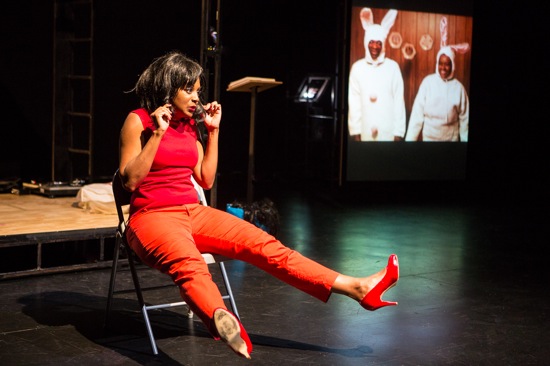
April Matthis in Ralph Lemon’s Scaffold Room. Onscreen: Brother and Sister Hare (Albert Johnson and Betty Clifton). Photo Yi-Chun Wu
I plan to iron out the creases and frame the flyer for The Kitchen’s fall season. It’s an art work by Ralph Lemon that also appears in Lemon’s installation and performance there, Scaffold Room. Tiny, brightly painted figures cross the sheet of paper in rows that disguise their parallel underpinnings. There are also words, so tiny as to be difficult to read. I spot images from Scaffold Room: a man in a rabbit suit, spaceships, a woman in a red dress sitting flat on the floor with her legs spread, a giraffe, musicians with their instruments, a little girl with a goat head, and many more. Oh, it’s a beautiful thing.
It’s also as bewitchingly, sometimes infuriatingly enigmatic as Lemon’s staged creation—an amalgam of music, text, visual art, and performance. For all these, it draws on earlier pieces of his, in particular the 2010 How Can You Stay in the House All Day and Not Go Anywhere? Here are members of the Carter family, friends Lemon made in the Mississippi delta when working on Come Home Charley Patton, the third and last part of his trilogy, Geography. Here is a closeup of Okwui Okpokwasili sobbing and sobbing, as she did in the earlier piece. Here is film of the wildly imaginative spaceship that Walter Carter built, and here is a reference to Andre Tarkovsky’s 1972 film Solaris.
But these are transformed and repositioned. A young man filmed just outside the doorway to a rehearsal studio weeps silently and inconsolably. Okpokwasili dons a silver spacesuit as Walter Carter once did, but I think the accompanying words she’s speaking are from Empire of the Senseless (1998), one of two Kathy Acker texts that are quoted in the performance. I think this because in Okpokwasili’s mention of a space ship, amid brainy, wild, erotic challenges, she addresses, or refers to, a “Peter” (Acker was married to composer Peter Gordon). In a film that’s part of the installation upstairs in The Kitchen’s gallery, Carter’s spaceship is being decked with flowers, and potted ones are being set in the ground by two men (Walter Carter’s son, Warren “Red” Carter, and Lloyd Williams (Walter Carter’s son) and two women (Carter’s wife, Lorraine, and Williams’s wife Emma); the women are dressed like nurses— in white and wearing white shoes. I’m guess this filmed scene, which makes a brief appearance in the performance downstairs, shows the creation of a memorial to Walter Carter, who was, I believe, 102 back in 2010.
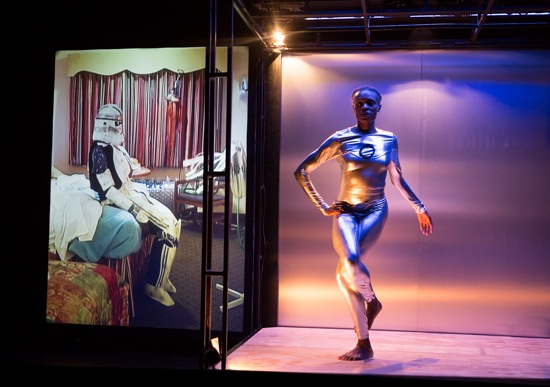
Okwui Okpokwasili, astronaut in Scaffold Room. In the film to her right, a home-grown spaceman. Photo: Yi-Chun Wu
Another mystery: one of the men struggles to put a little, hooded coat on a chained-up terrier; eventually there are two dogs dressed like this. One looks crestfallen; the other barks excitedly and wags its tail. It’s as if an astronaut had landed on an unfamiliar planet and found a look-alike (dream on, Fido).
While gazing at Lemon’s flyer, my eye catches a fragment of text. It seems to be a speech by “B.” “First off,” he says, I don’t give a fuck about a critic. Critics have no credibility. They’ve never lived in the hood; they didn’t grow up in the streets so how are they going to judge what I’m talking about.” Ouch. Well it’s true about my upbringing (Lemon’s too, I believe), and I’m aware that I don’t get all the cultural references embedded in The Scaffold Room. Although I definitely recognize one of Okpokwasili’s disguises as an Amy Winehouse hairdo, and I figure that performer April Matthis’s blond wig refers to Beyoncé.
This work of Lemon’s strikes me as a poetic assemblage of images to do with the body—the body defined by gender, by race, by political structures; the body enraged, violated, or launching itself into fabulous space—whether that other territory is in the sky, in the mind, or between the sheets. Scaffold Room defies logic, yet why should a small African American girl (Geneva Johnson) wearing a red dress and a goat’s head not be filmed sitting in a forest? Why wonder at her much older siblings (Albert Johnson and Betty Clifton) as they help each other onto rabbit suits and look a bit embarrassed about their new identities? Upstairs in the sparse collection of objects, elegantly lit, is a collection of small African (or pseudo African) sculptures collected by Lemon; someone, on his instructions, made tiny, sportive costumes for the them. I found out only later that their clothes copy outfits worn by Beyoncé and Jay Z. Can you picture this and intuit the gist of the conflated images? That’s the kind of fascinating thinking that Lemon comes up with.
I have time before the performance starts to sit on the floor of the gallery and stare at things, but I didn’t arrive earlier enough to hear one of several guests sit on a stool in a small, brightly lit white cubicle dubbed the Graphic Reading Room (Roderick Murray designed the splendid lighting throughout) and read from one of the books stacked against a wall: De Sade, Samuel R. Delany, Iceberg Slim, et al.
Lemon had rebellious ideas about audience seating. We mill, sit on the floor, lounge on two available sofas, until Murray starts handing out folding chairs, and people congregate with outstretched hands to grab one and set it up any old place, as long as it faces the set (R. Eric Stone, scenic design collaborator, and F. Randy deCelle, engineer/fabricator). Talk about a space ship! A small room of a stage with an overhead platform, a great screen that hinges out from it to received images projected from behind it, a long arm with a projector on it. You expect it to start lumbering around the room. Why “scaffold?” A framework for sure. (Also a site of executions?)
Okpokwasili is at first the only live performer. While her filmed self wails on the screen, she’s on the scaffold’s second floor jumping on the mattress. And jumping and jumping. Maybe this is how you prepare to be an astronaut. Amid the flood of silent, recurring film images—a ferocious drummer, a crowd of crazed, beer-swilling revelers turned on by the unheard music, more— she sings marvelously, her voice a sure, pure blast that rises and subsides, ululates. Later, she screams and jumps wildly, flinging herself around. But when she’s singing or speaking, she stands amazingly still—no dipping, no shrugging, no gesturing; her handsome face is stern. Only two words galvanize her into a gesture. One is “crash!” The other is “Mommy!” She draws you in; like an animal caught in a larger animal’s stare, you can’t look away from her. If you didn’t know the erotic acts she speaks of, you’d think that these are her own memories, printed on her body.
Names are named. Susan Sontag, Lady Gaga, Sasha Frere-Jones, Tarkovsky. And when April Matthis replaces Okpokwasili, more names hang in the air, setting off little explosions: Angela Davis, Hurricane Sandy, the correspondence between Lawrence Durrell and Henry Miller, Moms Mabley, Acker. Sitting spraddled on the floor, with her red dress and blond wig, Matthis sings in a squeaky little voice. A party girl. (I should mention that the costumes are by Naoko Nagata, that Marina Rosenfeld is listed as composer/turntablist, and that the additional songs heard are Janis Joplin’s “Little Girl Blue,” Carol Jones’s “Don’t Destroy Me,” and Belle and Sebastian’s “Waiting for the Moon to Rise.”)
Like Okpokwasili, Matthis alters her persona and her attire. She takes off the wig, and puts it on again. She speaks in her own voice. She channels Acker. She adopts a nasal voice to portray half a dialogue. Images cascade over the screen and cluster around my head like a storm of midges. Some are familiar from the exhibit e.g. the giraffe boy (Jayden Williams or Michael Sims). Talk of serious matters, rough deeds, and terrifying phenomena emerge startlingly from candied, flower-decked visions and family rituals.
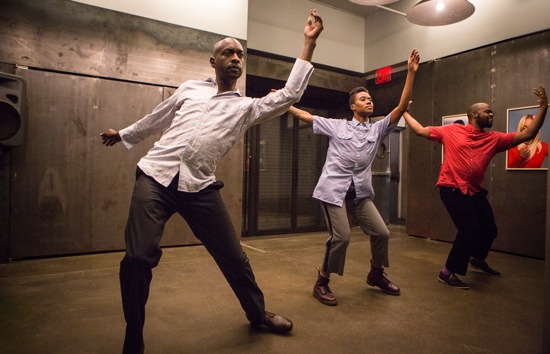
Scaffold Room‘s final dance: (L to R): Paul Hamilton, Omagbitse Omagbemi, and Malcolm Low. Photo: Yi-Chun Wu
Not until Scaffold Room ends (no bows, just darkness), do we fully take in the fact, that the only live performers we have seen are women; men are talked about, sung about, talked to, and shown onscreen. But as we rise from our chairs and start folding them, our focus is directed to the Kitchen’s lobby, whose wide doors have been opened. From where I’m standing, I can’t see Kevin Beasley, who’s got a turntable in the box office and is acting as a dj. Lined up facing us are three nimble men reminding us. . .what? That Lemon is a choreographer? That men, too, can be displayed to a proprietary gaze? That gender is porous? Yes, wait. One of the “men” is a woman, Omagbitse Omagbemi; I didn’t recognize her at first. She and the two men flanking her, Paul Hamilton and Malcolm Low, dance in unison, their minds on their steps, their assertive gazes occasionally on us. No flirting, but this is definitely a routine and a sexy, clever one. The music blasts out. After a while, it’s over. The performers walk out a door. My head is swimming. I walk out into the street.
Here’s another mystery. Lemon didn’t want any photographs of this last trio published until after the final performance on November 11. It was all right to mention their names (they were billed as “Chorus,” which opens up new avenues of speculation), even to say that they danced, but no photos. Zesty dancing as a dirty little secret? Art porn?
I’m stopping this right now.

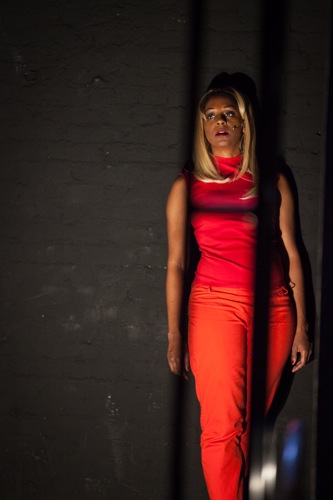
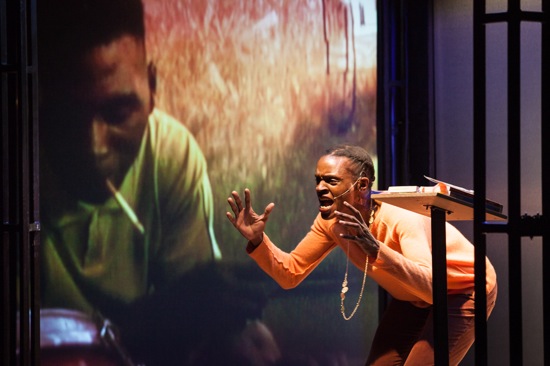
I suspect your review Deborah is a hell of a lot more fun than the show. I’ve not seen enough of Ralph Lemon’s work to comment on that, but I of course can’t resist saying something about “Fuck the critic, etc.” A lot of us are old (or to be pc about it, honored citizens, chronologically challenged, etc.) but none of us writing in the 21st century is old enough to have lived at the court of Louis the XIV, or Peter the Great, or Weimar Germany, or Isadora Duncan’s California, or, or, or. Do we have to have experienced in our lives what artists are making art about? I don’t think so. As the daughter of a visual artist I was brought up to view critics with suspicion at best, and am therefore highly ambivalent about what we do, so I do welcome witty, emphasis witty, statements about us from artists, my favorite of which is Todd Bolender’s: “critics are aphids,” he wrote to his friend Joel Schnee many years ago. A perfect metaphor and I won’t name the now deceased critic he was skewering.